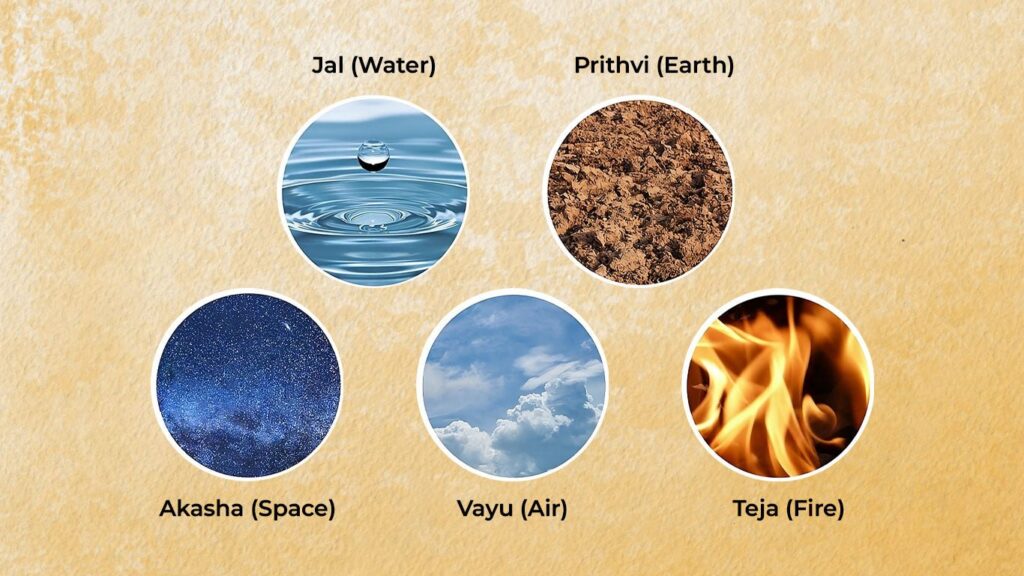Ayurveda, the ancient system of holistic healing, is deeply rooted in the philosophy of the five great elements or “Pancha Tattva.” These five elements—Earth (Prithvi), Water (Jala), Fire (Agni), Air (Vayu), and Ether (Akasha)—are considered the fundamental building blocks of the universe. According to Ayurveda, everything in the cosmos, including the human body, is composed of these elements. Understanding Pancha Tattva is essential for grasping the concepts of health, disease, and balance in Ayurveda.
The Five Elements: Pancha Tattva
- Earth (Prithvi)
- Qualities: Stability, solidity, and heaviness.
- Role in the Body: Earth represents the solid structures of the body, including bones, muscles, tissues, and skin. It provides stability and endurance. In nature, Earth is associated with firmness and grounding, and within the human body, it manifests as physical strength and robustness.
- Influence on Health: A balanced Earth element contributes to strength, endurance, and resilience. However, an excess can lead to weight gain, stagnation, and a sense of heaviness, while a deficiency can cause frailty, weakness, and instability.
- Water (Jala)
- Qualities: Fluidity, cohesiveness, and coolness.
- Role in the Body: Water is responsible for all bodily fluids, including blood, lymph, saliva, and digestive juices. It provides lubrication, moisture, and flexibility to tissues and organs. Water is also essential for maintaining the smooth functioning of bodily processes, such as digestion and circulation.
- Influence on Health: A balanced Water element ensures hydration, smooth digestion, and clear thinking. An excess can result in edema, congestion, and emotional heaviness, while a deficiency may lead to dryness, dehydration, and inflexibility.
- Fire (Agni)
- Qualities: Heat, transformation, and intensity.
- Role in the Body: Fire governs digestion, metabolism, and energy production. It is responsible for the conversion of food into energy and nutrients, as well as the clarity of perception and intellect. Fire also plays a crucial role in maintaining body temperature and vitality.
- Influence on Health: Balanced Fire leads to strong digestion, a sharp mind, and radiant health. When in excess, it can cause inflammation, anger, and hyperacidity. A deficiency in Fire can result in sluggish digestion, poor circulation, and lack of enthusiasm.
- Air (Vayu)
- Qualities: Movement, lightness, and mobility.
- Role in the Body: Air controls all movement in the body, including breathing, circulation, nerve impulses, and the movement of thoughts and emotions. It is responsible for the flow of energy and communication within the body and mind.
- Influence on Health: When Air is balanced, it promotes flexibility, creativity, and proper functioning of the nervous system. Excessive Air can lead to anxiety, restlessness, and dryness, while a deficiency may cause sluggishness, depression, and poor circulation.
- Ether (Akasha)
- Qualities: Space, openness, and subtlety.
- Role in the Body: Ether represents the spaces within the body, such as the cavities in the lungs, digestive tract, blood vessels, and cells. It provides the space necessary for movement and communication within the body.
- Influence on Health: Balanced Ether creates a sense of openness, calmness, and awareness. An excess can lead to a feeling of emptiness, isolation, and detachment, while a deficiency may result in a lack of creativity, mental blockages, and constriction.
The Interplay of Pancha Tattva in the Human Body
In Ayurveda, health is seen as a state of balance between the Pancha Tattva within the body and mind. These elements combine in various ways to form the three Doshas—Vata, Pitta, and Kapha—which are the primary forces that govern physiological functions.
- Vata Dosha: Comprised of Air and Ether, Vata is responsible for movement, communication, and the nervous system.
- Pitta Dosha: Comprised of Fire and Water, Pitta governs digestion, metabolism, and transformation.
- Kapha Dosha: Comprised of Earth and Water, Kapha provides structure, stability, and lubrication.
The balance or imbalance of these Doshas determines an individual’s physical, mental, and emotional health. By understanding the Pancha Tattva and their influence on the Doshas, Ayurveda offers personalized approaches to maintaining health, preventing disease, and restoring balance.
The Role of Pancha Tattva in Daily Life
Ayurveda teaches that maintaining a harmonious relationship with the Pancha Tattva is essential for health and well-being. This involves aligning one’s lifestyle, diet, and activities with the natural rhythms and cycles of these elements. For instance, consuming foods and engaging in activities that balance the predominant element in your constitution can help maintain overall health. Meditation, yoga, and pranayama are also recommended to harmonize the mind and body with the Pancha Tattva.
Conclusion
The concept of Pancha Tattva in Ayurveda is a profound way of understanding the interconnectedness of the universe and the human body. Each element plays a crucial role in maintaining balance and health, and by cultivating an awareness of these elements, we can live in harmony with nature and ourselves. Ayurveda’s holistic approach, rooted in the principles of Pancha Tattva, offers a timeless guide for achieving and sustaining optimal health and well-being.

